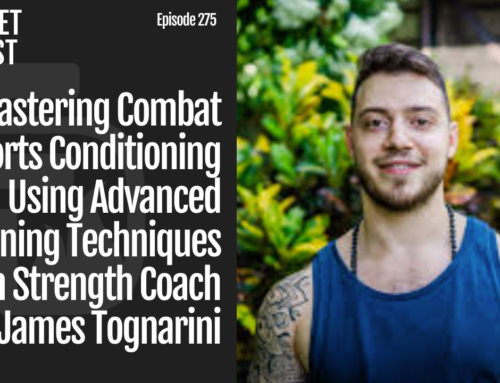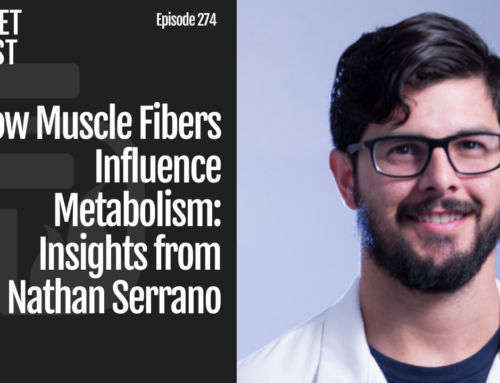This podcast reviews a concept I teach in the Physiologic Flexibility Certification to enhance performance when lifting. The great news is you can learn these techniques without any special technology. Learn how to direct your focus and control your breathing to ramp up and then recover.
Episode Notes
- Far off gaze parasympathetic
- Close up gaze sympathetic
- Parasympathetic for rest and recovery
- Sympathetic for performance
- Breathing techniques to regulate heart rate
- Protocol in Phys Flex Cert
- Overview of Phys Flex Cert course
This podcast is brought to you by the Physiologic Flexibility Certification course. In the course, I talk about the body’s homeostatic regulators and how you can train them. The benefit is enhanced recovery and greater robustness. We cover breathing techniques, CWI, sauna, HIIT, diet, and more. The deadline to enroll is midnight PST Sept 20, 2021. If you’re outside the window, sign up for the waitlist, and you’ll be notified as soon as the course opens.
Rock on!

Dr. Mike T Nelson

Dr. Mike T Nelson
PhD, MSME, CISSN, CSCS Carrick Institute Adjunct Professor Dr. Mike T. Nelson has spent 18 years of his life learning how the human body works, specifically focusing on how to properly condition it to burn fat and become stronger, more flexible, and healthier. He’s has a PhD in Exercise Physiology, a BA in Natural Science, and an MS in Biomechanics. He’s an adjunct professor and a member of the American College of Sports Medicine. He’s been called in to share his techniques with top government agencies. The techniques he’s developed and the results Mike gets for his clients have been featured in international magazines, in scientific publications, and on websites across the globe.
- PhD in Exercise Physiology
- BA in Natural Science
- MS in Biomechanics
- Adjunct Professor in Human
- Performance for Carrick Institute for Functional Neurology
- Adjunct Professor and Member of American College of Sports Medicine
- Instructor at Broadview University
- Professional Nutritional
- Member of the American Society for Nutrition
- Professional Sports Nutrition
- Member of the International Society for Sports Nutrition
- Professional NSCA Member
Protocol To Enhance Lifting Performance
Welcome back to the flex diet podcast. I’m your host, Dr. Mike D. Nelson. On this podcast, we talk all about things you can do to enhance your performance, could be in the gym could be in life, add more muscle, better body composition, all without destroying your health in the process. Today, it is brought to you by the physiologic flexibility certification. If you’re listening today, and when this podcast came out on Monday, September 20 2021, this is the last day to get into the physiologic flexibility certification for this year, go to physiologic flexibility calm for all the information there.
And if you’re listening outside of that time period, you can go to the same link, physiologic flexibility, calm, and you’ll be able to get on the waitlist for the next time that it opens, you will be the first to be notified. And I’ve got lots of great daily free content for you there too. So go to physiologic flexibility.com. Today just wanted to review a concept that I teach and the physiologic flexibility cert that I don’t see a lot of people talking about, but I’ve seen very high level lifters do this combination of techniques to enhance performance a lot of the time.
Now again, I think they’re doing it when I’ve talked to them about it kind of unconsciously, that their body and brain has figured out that this works well. I don’t think they’re doing it necessarily consciously. But what’s cool is it’s can be taught, and you don’t need any special techniques in terms of technology to do these techniques. They are free. And they involve the interaction of breathing and your eye function. So Dr. Andrew Huberman has talked about how your eye function is related to your autonomic nervous system. So check out his podcast and all of his amazing information. If I am doing meditation outside, I want to have a more open gaze. Imagine looking at the ocean. So sitting on the beach, this kind of very panoramic view, most people feel quite relaxed doing that.
So a more relaxed gaze panoramic view is more on the para sympathetic side of your nervous system. This is the rest and digest branch of the autonomic nervous system, like pushing down on the brake pedal on your car, you’re slowing down heart rate, I’m increasing something called vagal tone, and becoming more para sympathetic, more rest and relax, better digestion, etc. If I now change my focus of my eyes to a position that is very close in front of me, say I put my hands out about a foot two feet within distance from my eyes. And I focus exclusively on the tip of my finger, that will drive my nervous system a little bit more sympathetic. And you can use this technique with lifting.
So before a lift, I probably want to be more sympathetic, or a little more fight or flight, hopefully not freeze. When I’m in between sets, I want to be more para sympathetic, I want the ability to be more relaxed, I want the ability to recover a little bit. Again, if you are trying to stay on the entire time for a lifting session or a big game or whatever you’re doing for performance. I think some athletes can get away with that for a period of time. But what I’ve seen is the cost is very high.
So if you look at their heart rate variability scores the next day, they tend to still be a little bit more sympathetic. people I’ve talked to who have worked with a lot of let’s say NHL players, the sympathetic monsters who show up through their facility. Do good for two, three, maybe four years. And then they seem to just kind of disappear. The athletes who can better regulate being on when they need to and off when they need to. They anecdotally tend to last much longer, you know, sometimes over a decade in the NHL, for example. And my biases, I think this applies to other sports, and even just lifting in the gym. So I position and what you do with your eyes, has an effect on your autonomic nervous system. So just think about that the next time you are between sets.
And when you are focused on right before doing a set or during the exercise itself. At that point, you want to be very sympathetic. If you have you ever tried to exercise when your max heart rate is not able to get really high, maybe you have extreme levels of fatigue, or you’re kind of pair sympathetically overreached, you find that your performance is actually not very good. So again, we want the ability to be sympathetic when we need to, we want the ability to be more parasympathetic and relaxed when we need to, I think it’s a skill set we can teach to go back and forth between being parasympathetic and sympathetic, I think that will result and a much better level of performance at a lower cost in order to do it. Now we can start layering in other things here.
Another thing we can layer in, for example, would be breathing techniques. If we are breathing, let’s say we’ll just look at speed. If we are breathing faster, that is more on the sympathetic side of the spectrum. If we are breathing slower, our respiratory rate or frequency is slower, we are more on the para sympathetic side. So again, we can use this to our advantage for lifting. So in between sets, we’re going to work to try to lower our breathing rate, which again with rest will automatically happen also. And then we can increase it slightly before a big lift.
Now, I would not go so far as to do a ton of hyperventilation, or super ventilation techniques before a big lift. Because if you get really crazy with that, there is a risk you can pass out or feel dizzy, you definitely do not want to do that holding dumbbells over your face, having a loaded barbell on your back. Or even something that you think may be relatively safe, like a deadlift gives me a flashback to a story in Costa Rica a couple years ago, where we had a contest down there, and a guy dropped 500 pound trap bar, and it bounced and it sliced the end of his toe off.
So again, all of these things carry risks. So you want to make sure it is very short and very controlled. I would not start doing a bunch of Wim Hof or super ventilation methods before a max lift. But for most people, like you know, two or three fast inhales will do the trick. Again, make sure that you practice this without any load practices in your warm ups and make sure that you do not get dizzy, lightheaded or anything like that goes without saying, always lift if you’re doing squats and other exercises in a cage, so if something goes wrong, same with bench press, that you’re going to be in a safe environment.
So speed of lifting is something else we can play with, I should say speed of breathing, to match lifting for performance. So so far on the list, we’ve got eyes and what they’re looking at wide or narrow. And we’ve got breathing rate so fast or slow. Now we can go even beyond and I break down the full protocol and the physiologic flexibility cert of nasal versus mouth breathing. So in short, nasal breathing, and there is research on this is more on the parasympathetic side. Mouth breathing is a little bit more on the sympathetic side. We can also play around with the duration of the inhale versus the exhale as we Inhale something called respiratory sinus arrhythmia, or RS, A, which is arrhythmia, but not necessarily a bad thing. As we inhale and exhale, our heart rate changes a little bit.
And we can measure this by using heart rate variability. So if we inhale, we get a little bit more sympathetic, we are increasing the heart rate a little bit. When we exhale, we are decreasing heart rate a little bit. So again, by playing around with either nasal versus mouth, longer inhale versus exhale, are your ratio of those two, we can then also bias your nervous system a little bit more towards parasympathetic, or sympathetic. And we can use these techniques during lifting, we could use these techniques to get ready for a big session, or a big lift, we can then also use them for periods of recovery. So when you are doing breathing techniques or meditation, we can then bias you more towards a para sympathetic side.
And what’s super cool is if you’re measuring heart rate variability, you can then determine at that point in time is your body more on the parasympathetic or the sympathetic side. And that’ll also give you some information about how to use these techniques. So a quick example on that is, so for example, today, when I’m recording this, I’m a little bit more on the sympathetic side. And I’ve done HRV enough to know that I’ve got a bigger session for lifting today, and I will be fine. But if that trend had continued for more than a couple days, I’m going to try to buy us things that I know are more on the parasympathetic side.
So I would do more meditation breathing outside, I would do a relaxed, panoramic view, I would go more with nasal breathing, and I would go more with a longer exhale, all of those are going to bias me more to the para sympathetic side. For exercise, I usually will do more lower to moderate intensity, cardiovascular training. And even with that, I can then bias my breathing to more nasal in and out that also limits the intensity techniques, so that I am not going too far on the sympathetic side. So again, this is pretty cool, I think.
And I don’t see or haven’t seen a lot of people put it together all in one. So shameless plug in the fist flexor, we go through all the mechanisms of this, all of the background and the oxygen in the co2 regulation, what is going on? Why that homeostatic regulator such as oxygen and co2 levels in the body is a big deal. There’s some very fascinating data also on something called a cross adaptation. Looking at cold water immersion, or exposure, and your ability to handle a low oxygen environment, here’s a hint it actually up regulates your ability to do that.
So not only are there specific things you can do for your nervous system, like we just discussed, as you target the other homeostatic regulators, there appears to be some cross adaptation effects there. So doing cold water immersion, even though it has everything to do with temperature, this cellular mechanistic level, it may allow you to be better at times with less oxygen. So again, and may allow you to be better on some more exhaustive exercise.
So on the physiologic flexibility assert, we show you how to target the four main homeostatic regulators, one of them being temperature, pH, fuel systems, so glucose and ketones, and then also oxygen and carbon dioxide. And then we break it down and make it applicable with specific action items that you can do that are relatively simple to do most of them you don’t need a lot of expensive technology. You can add some technology if you want recover both. So this protocol of how to enhance acute lifting performance, and do it at a lower cost so that you are able to do more of it. So today if you’re listening to this on Monday, September 20 is the last time that open enrollment is going on for the fist flex cert for this year 2021. So go to physiologic flexibility.com. And you will be able to get all the information and enroll there. If you’re listening to this after that time still go to the same URL, physiologic flexibility.com. And you’ll be able to get on the waitlist for the next time that it opens. So thank you so much, really appreciate it. We will talk to you soon.














Leave A Comment